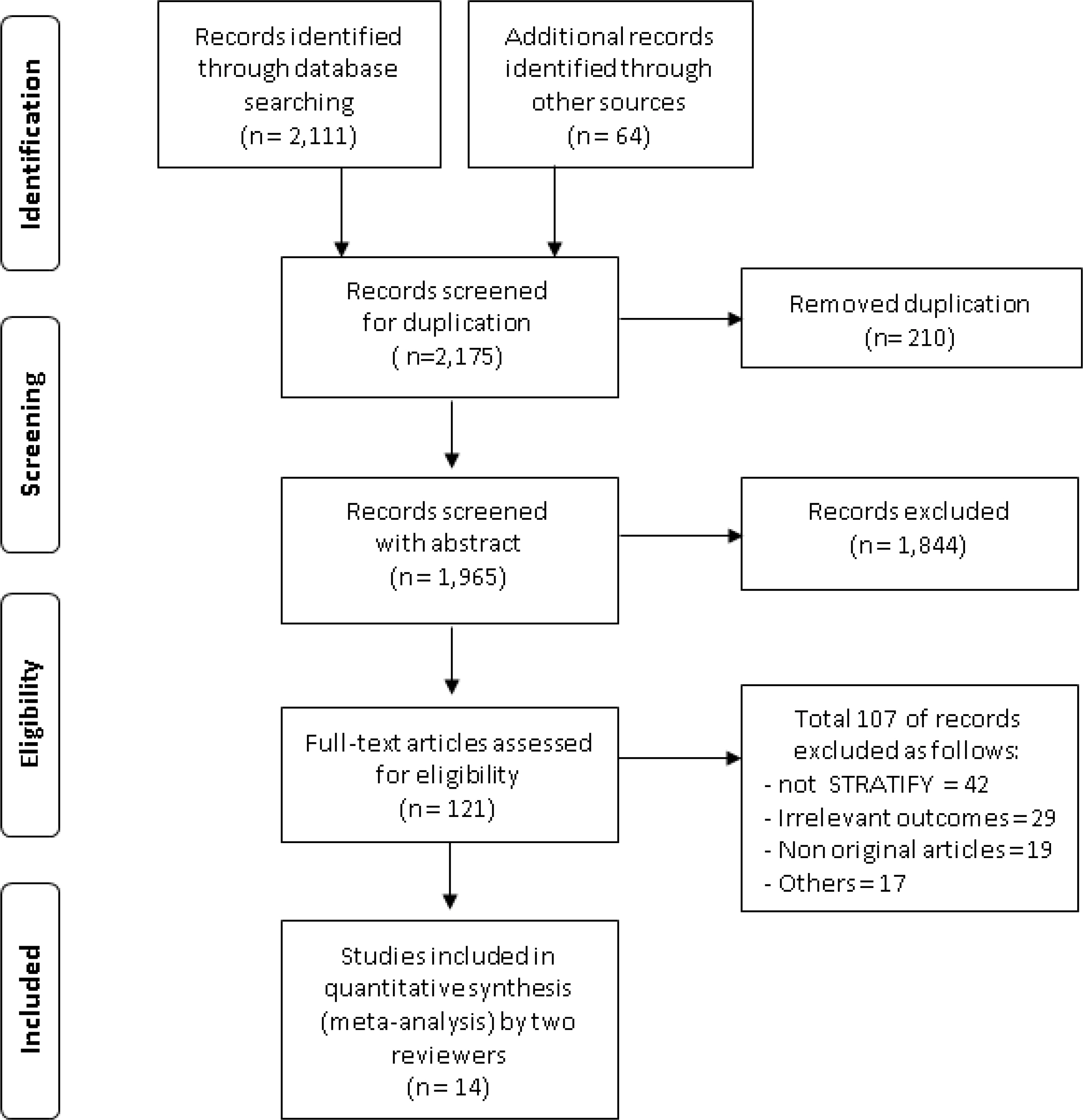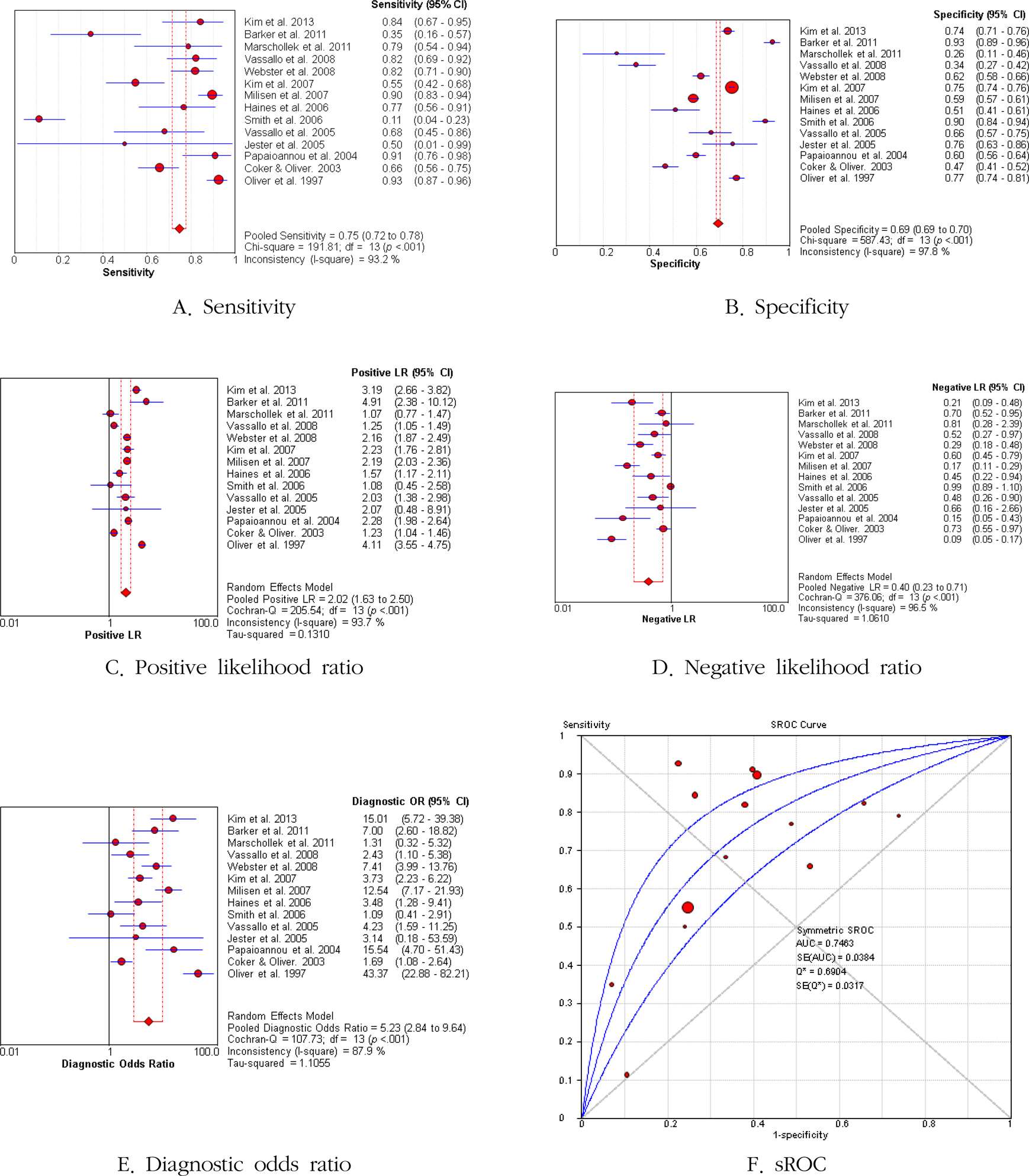Korean J Adult Nurs.
2015 Oct;27(5):559-571. 10.7475/kjan.2015.27.5.559.
Predictive Validity of the STRATIFY for Fall Screening Assessment in Acute Hospital Setting: A meta-analysis
- Affiliations
-
- 1Department of Nursing, Soonchunhyang University, Cheonan, Korea.
- 2Department of Nursing, Korea National Open University, Seoul, Korea.
- 3Department of Health Administration, Hanyang Cyber University, Seoul, Korea. jeonghae.hwang@gmail.com
- KMID: 2221734
- DOI: http://doi.org/10.7475/kjan.2015.27.5.559
Abstract
- PURPOSE
This study is to determine the predictive validity of the St. Thomas Risk Assessment Tool in Falling Elderly Inpatients (STRATIFY) for inpatients' fall risk.
METHODS
A literature search was performed to identify all studies published between 1946 and 2014 from periodicals indexed in Ovid Medline, Embase, CINAHL, KoreaMed, NDSL and other databases, using the following key words; 'fall', 'fall risk assessment', 'fall screening', 'mobility scale', and 'risk assessment tool'. The QUADAS-II was applied to assess the internal validity of the diagnostic studies. Fourteen studies were analyzed using meta-analysis with MetaDisc 1.4.
RESULTS
The predictive validity of STRATIFY was as follows; pooled sensitivity .75 (95% CI: 0.72~0.78), pooled specificity .69 (95% CI: 0.69~0.70) respectively. In addition, the pooled sensitivity in the study that targets only the over 65 years of age was .89 (95% CI: 0.85~0.93).
CONCLUSION
The STRATIFY's predictive validity for fall risk is at a moderate level. Although there is a limit to interpret the results for heterogeneity between the literature, STRATIFY is an appropriate tool to apply to hospitalized patients of the elderly at a potential risk of accidental fall in a hospital.
MeSH Terms
Figure
Cited by 1 articles
-
Systematic Review and Meta-analysis for Usefulness of Fall Risk Assessment Tools in Adult Inpatients
Seong-Hi Park, Eun-Kyung Kim
Korean J Health Promot. 2016;16(3):180-191. doi: 10.15384/kjhp.2016.16.3.180.
Reference
-
1.Shorr RI., Mion LC., Chandler AM., Rosenblatt LC., Lynch D., Kessler LA. Improving the capture of fall events in hospitals: combining a service for evaluating inpatient falls with an incident report system. Journal of American Geriatric Society. 2008 Apr. 56(4):701–4. http://dx.doi.org/10.1111/j.1532-5415.2007.01605.x.
Article2.Oliver D., Papaioannou A., Giangregorio L., Thabane L., Reizgys K., Foster G. A systematic review and meta-analysis of studies using the STRATIFY tool for prediction of falls in hospital patients: how well does it work? Age and Ageing. 2008. 37(6):621–7. http://dx.doi.org/10.1093/ageing/afn203.
Article3.Everhart D., Schumacher JR., Duncan RP., Hall AG., Neff DF., Shorr RI. Determinants of hospital fall rate trajectory groups: a longitudinal assessment of nurse staffing and organizational characteristics. Health Care Management Review. 2014. 39(4):352–60. http://dx.doi.org/10.1097/HMR.0000000000000013.4.Yang HM., Chun BC. Falls in the general hospital inpatients: incidence, associated factors. Journal of Korean Society of Quality Assurance in Health Care. 2009. 15(2):107–20.5.Healey F., Scobie S., Oliver D., Pryce A., Thomson R., Glampson B. Falls in English and Welsh hospitals: a national observational study based on retrospective analysis of 12 months of patient safety incident reports. Quality & Safety in Health Care. 2008. 17(6):424–30. http://dx.doi.org/10.1136/qshc.2007.024695.
Article6.Wong C., Recktenwald A., Jones M., Waterman B., Bollini M., Dunagen W. The cost of serious fall-related injuries at three midwestern hospitals. The Joint Commission Journal on Quality and Patient Safety. 2011. 37(2):81–7.
Article7.Centers for Medicare & Medicaid Services. Medicare program; listening session on hospital-acquired conditions in inpatient settings and hospital outpatient healthcare-associated conditions in outpatient settings [Internet]. Federal Register. 2008. 73(211):64618–9. [cited 2015 March 10]. Available from:. http://www.cms.gov/Medicare/Medicare-Fee-for-Service-Payment/HospitalAcqCond/downloads/1422_N_FEDERAL_REGISTER_VERSION_PUB_10_30_08_508.pdf.8.Ganz DA., Huang C., Saliba D, et al. Preventing falls in hospitals: a toolkit for improving quality of care [Internet]. Rockville, MD: Agency for Healthcare Research and Quality;2013 January. AHRQ Publication No.: 13-0015-EF. [cited 2015 March 10]. Available from:. http://www.ahrq.gov/professionals/systems/hospital/fallpxtoolkit/index.html.9.Korea Ministry of Government Legislation. Patient safety act [Internet]. Sejong Metropolitan Autonomous City: Korea Ministry of Government Legislation;2015. [cited 2015 March 30]. Available from:. http://law.go.kr/lsInfoP.do?lsiSeq=167782&efYd=20160729#0000.10.Myers H., Nikoletti S. Fall risk assessment: a prospective investigation of nurses'clinical judgement and risk assessment tools in predicting patient falls. International Journal of Nursing Practice. 2003. 9(3):158–65. http://dx.doi.org/10.1046/j.1440-172X.2003.00409.x.11.The Joint Commission. 2015 Comprehensive accreditation manual for hospitals. Oak Brook, IL: Joint Commission Resources;2014.12.Ministry of Health & Welfare, Korea Institute for Healthcare Accreditation [KOIHA]. Guideline for healthcare accreditation [Internet]. Seoul: KOIHA;2014. [cited 2015 January 10]. Available from:. https://www.koiha.or.kr/home/data/data/doView.act.13.The Victorian Quality Council. Minimizing the risk of falls & fall-related injuries: guidelines for acute, sub-acute and residental care setting [Internet]. Melbourn Victoria: the Metropolitan Health and Aged Care Services Division Victorian Government Department of Human Services. 2004. July. [cited 2015 March 10]. Available from:. http://www.health.vic.gov.au/qualitycouncil/downloads/falls/research.pdf.14.Morse JM. Computerized evaluation of a scale to identify the fall-prone patient. Canadian Journal of Public Health. 1986. 77(suppl 1):21–5.15.Schmid NA. Reducing patient falls: a research-based comprehensive fall prevention program. Military Medicine. 1990. 155:202–7.16.Hendrich A., Nyhuuis A., Kippenbrock T., Soga ME. Hospital falls: development of a predictive model for clinical practice. Applied Nursing Research. 1995. 8(3):129–39. http://dx.doi.org/10.1016/S0897-1897(95)80592-3.
Article17.Poe SS., Cvach M., Dawson BP., Straus H., Hill EE. The Johns Hopkins fall risk assessment tool: postimplementation evaluation. Journal of Nursing Care Quality. 2007. 22(4):293–8. http://dx.doi.org/10.1097/01.NCQ.0000290408.74027.39.18.Kim KS., Kim JA., Choi YK., Kim YJ., Park MH., Kim HY, et al. A comparative study on the validity of fall risk assessment scales in Korean hospitals. Asian Nursing Research. 2011. 5(1):28–37. http://dx.doi.org/10.1016/S1976-1317(11)60011-X.
Article19.Oliver D., Daly F., Martin FC., McMurdo ME. Risk factors and risk assessment tools for falls in hospital inpatients: a systematic review. Age and Ageing. 2004. 33(2):122–30. http://dx.doi.org/10.1093/ageing/afh017.
Article20.The Joint Commission. Defining the problem of falls. Smith I.J., editorReducing the risk of falls in your health care organization. Oak Brook, IL: Joint Commission Resources;2012.21.Macaskill P., Gatsonis C., Deeks JJ., Harbord RM., Takwoingi Y. Analysing and presenting results. Deeks JJ, Bossuyt PM, Gatsonis C, editors. Cochrane handbook for systematic reviews of diagnostic test accuracy version 1.0 [Internet]. The Cochrane Collaboration;2010. [cited 2013 May 30]. Available from:. http://srdta.cochrane.org/.22.Moher D., Liberati A., Tetzlaff J., Altman DG., Antes G., Atkins D, et al. Preferred reporting items for systematic reviews and meta-Analyses: The PRISMA statement. Annals of Internal Medicine. 2009. 151(4):264–9. http://dx.doi.org/10.7326/0003-4819-151-4-200908180-00135.
Article23.Whiting PF., Rutjes AW., Westwood ME., Mallett S., Deeks JJ., Reitsma JB, et al. QUADAS-2: a revised tool for the quality assessment of diagnostic accuracy studies. Annals of Internal Medicine. 2011. 155(8):529–36. http://dx.doi.org/10.7326/0003-4819-155-8-201110180-00009.
Article24.Zamora J., Abraira V., Muriel A., Khan KS., Coomarasamy A. Meta-DiSc: a software for meta-analysis of test accuracy data. Medical Research Methodology. 2006. 6:31–42. http://dx.doi.org/10.1186/1471-2288-6-31.
Article25.Greiner M., Pfeiffer D., Smith RD. Principles and practical application of the receiver-operating characteristic analysis for diagnostic tests. Preventive Veterinary Medicine. 2000. 45(1-2):23–41.
Article26.Walter SD. Properties of the summary receiver operating characteristic (SROC) curve for diagnostic test data. Statistics in Medicine. 2002. 21(9):1237–56. http://dx.doi.org/10.1002/sim.1099.
Article27.Higgins JP., Thompson SG. Quantifying heterogeneity in a meta-analysis. Statistics in Medicine. 2002. 21(11):1539–58. http://dx.doi.org/10.1002/sim.1186.
Article28.Knottnerus JA. The evidence base of clinical diagnosis. Park SH, Kang CB, translator. Seoul: E-Public;2008.29.Sousa MR., Ribeiro AL. Systematic review and meta-analysis of diagnostic and prognostic studies: a tutorial. Arquivos Brasi-leiros de Cardiologia. 2009. 92(3):229–38. http://dx.doi.org/10.1590/S0066-782X2009000300013.30.Hill K., Vrantsidis F., Jessup R., McGann A., Pearce J., Collins T. Design-related bias in hospital falls risk screening tools predictive accuracy evaluations: systematic review and meta-analysis. Australasian Journal of Pordiatric Medicine. 2004. 38(2):99–108.
- Full Text Links
- Actions
-
Cited
- CITED
-
- Close
- Share
- Similar articles
-
- Comparison of the Reliability and Validity of Fall Risk Assessment Tools in Patients with Acute Neurological Disorders
- Systematic Review and Meta-analysis for Usefulness of Fall Risk Assessment Tools in Adult Inpatients
- Predictive Effects of Previous Fall History on Accuracy of Fall Risk Assessment Tool in Acute Care Settings
- A Comparative Study on the Validity of Fall Risk Assessment Scales in Korean Hospitals
- Validation of Fall Risk Assessment Scales among Hospitalized Patients in South Korea using Retrospective Data Analysis



